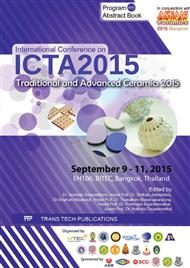p.12
p.18
p.23
p.28
p.33
p.39
p.45
p.51
p.57
Turning Electric Arc Furnace Dust Waste into Oil Spot Ceramic Glaze
Abstract:
Electric Arc Furnace (EAF) is commonly used in steel recycling industries. Apart from steel metal product, a waste in the form of dust is also produced and so called EAF dust. The fine particulates mainly contain zinc-iron oxides along with a small amount of heavy metals like chromium and lead, and have been categorized as a toxic waste. Proper treatments can be crucially required in order to recover crude zinc oxide and iron oxide from the dust; however, no practical recycling plants have been now readily operated in Thailand. To reduce its toxicity, EAF dust could be mixed with silica-based materials and vitrified into glass. Therefore, EAF dust can possibly be employed as a ceramic glaze raw material. This work pointed out how to make decorative “oil spot” ceramic glaze by substitution of EAF dust for a conventional iron oxide. The prepared glaze mixtures were applied over the ceramic bodies and fired at 1250 °C in oxidation atmosphere. The as-fired glaze appearances with tiny and silvery crystals floating over dark brown based-glaze were exhibited. Phase content and characteristics of the obtained glaze were analyzed. The roles of zinc oxide to iron oxide ratios on oil spot and crystal generation was concerned. A comparison of oil spot effects due to different iron oxide sources was presented and discussed. Oil spot glaze made from a combination of EAF dust and iron oxide powder was also proposed.
Info:
Periodical:
Pages:
33-38
Citation:
Online since:
May 2016
Price:
Сopyright:
© 2016 Trans Tech Publications Ltd. All Rights Reserved
Share:
Citation:


